
JUST when it started to get hot in June, I wrapped up my spring 2022 Lower East Side meanderings with a walk east on Kenmare and Delancey Streets. Kenmare Street runs east to west from Lafayette Street to the Bowery where it changes its name to Delancey, slotted in between Broome and Spring. However, Kenmare Street’s numbering runs east to west, so officially, it begins at the Bowery. Kenmare Street did not exist on Manhattan maps before 1911; in that year, traffic from the new Williamsburg Bridge (still mainly of the horse and cart variety) caused Delancey Street to be widened and a new street opened west of the Bowery as far as Lafayette, itself a new Manhattan street at the time; it was extended south from Lafayette Place in the Cooper Square area. Early 20th Century politician and labor leader “Big Tim” Sullivan had Kenmare Street named for the location in Ireland where his mother was born. The street is located in a region known as Nolita, or “North of Little Italy” and it touches on that neighborhood as well as the expanding Chinatown.
The BMT got busy with Kenmare Street right away, running the BMT Nassau-Jamaica line under it in 1913 on its way to crossing the mighty Williamsburg.
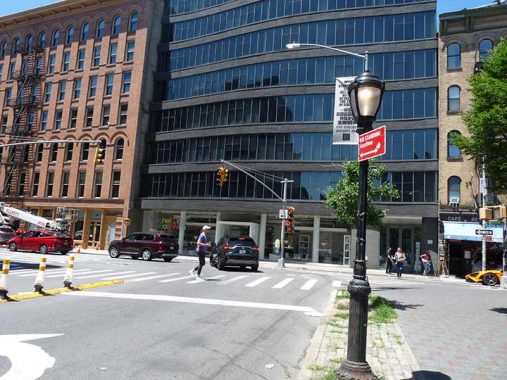
The Andre Balazs development, 210 Lafayette aka One Kenmore Square, was built in 2005. It has an undulating exterior, a common factor in early 21st century architecture. I seem to remember a gas station on this site in my 1980s wanderings, so can any Forgotten Fans confirm that notion? Comments are officially open.
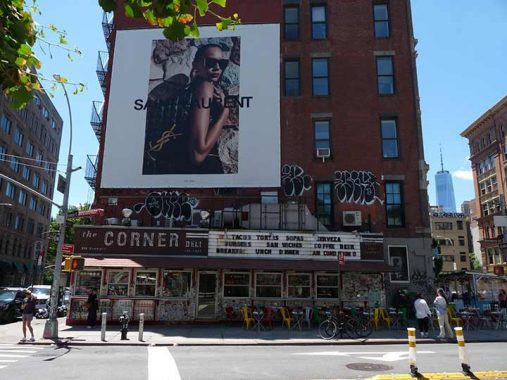
The Corner Deli and the La Esquina Mexican restaurant occupy a former diner on Kenmare east of Lafayette. I have never sampled the fare at La Esquina but remain fascinated with it nonetheless because it employs and old-time movie marquee, complete with plastic lettering. What diner occupied the space previously?
Lt. Joseph Petrosino Park at the triangle formed by Lafayette, Kenmare and Cleveland Place. It was named for a pioneering anti-Mafia detective in the early 20th Century:
When he joined the Police Department in 1883, Petrosino was the city’s shortest officer, at five feet and three inches tall. Police Commissioner Theodore Roosevelt personally promoted him to Sergeant of Detectives in 1895. While investigating anarchists in the United States, Petrosino warned President McKinley of threats against his life; however, the warning was not heeded and the President was assassinated in 1901.
Within ten years, Petrosino was named lieutenant and given command of the new Italian Squad, a unit created to combat the crime organization known as the Black Hand. Under his leadership, several thousand arrests were made, and more than 500 offenders were sent to prison. Crimes against Italian-Americans dropped by fifty percent. Petrosino was killed while on assignment to Palermo, Sicily.
When his body was returned to New York, thousands of mourners formed a funeral procession which marched from Little Italy to Calvary Cemetery in Queens. Lt. Petrosino was the only New York police officer who had died in the line of duty outside the United States. The park named in his honor is located just north of the Renaissance Revival edifice at 240 Centre Street, which served as Police Headquarters from 1910 to 1971. [NYC Parks ]
Petrosino Park seems continually under renovation; I have counted three since 2010: but it is open again and Parks is apparently content with it for now.

What may be one of the narrowest buildings in NYC is here, at the NE side of #87-97 Kenmare at Cleveland Place. Here is what it looked like in 1940; its bay windows have been retained. It is just 3 and a half feet wide here, extending to 19 feet as you go east! This arrangement came about when Kenmare Street was bruited through #15 Marion Street, now known as Cleveland Place, leaving a sliver of property that was nonetheless developed into a building. Tom Miller, the indefatigable Daytonian in Manhattan, has the story of its various colorful tenants over the years, including an interior shot.
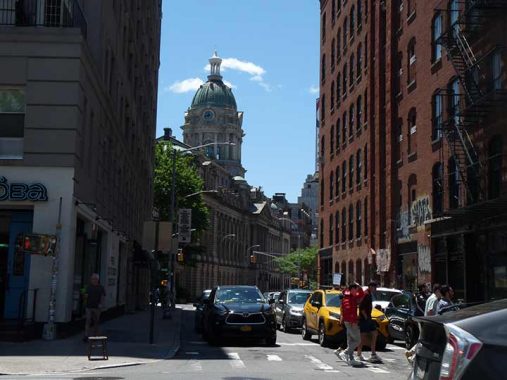
Looking south on Cleveland Place, renamed from Marion Street to honor President Grover Cleveland (1837-1908), who had been Governor of NYS, toward the domed former NYPD Headquarters, 240 Center Street, located in a wedge between Centre, Grand, Broome, and Centre Market Place. Currently a super-luxury apartment building called Police Building Apartments, it was designed by Hoppin & Krohn and completed in 1909 just as the Beaux Arts movement was beginning to wind down and modernism was around the corner. The lions in front look rather more fierce than the two at the New York Public Library – as befits Police HQ. It was converted to luxury use in 1988, a very early harbinger of the luxe trend that would take hold in Soho in the following decade.
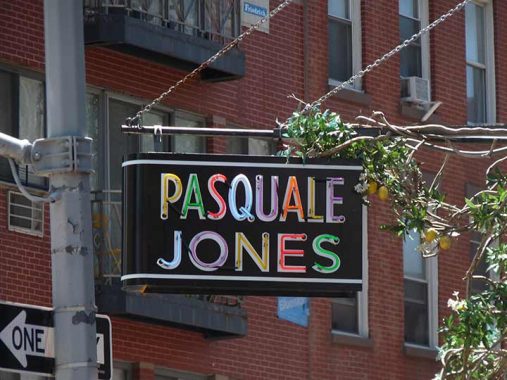
Since I am both a Philistine and have the culinary tastes of a 12-year-old, I’ll skip the clam pizza that Pasquale Jones at Mulberry and Kenmare is renowned for (it’s plain or pepperoni for me), but don’t let me stop you. I did dig the retro neon sign, which has the curves and proportions of other classic shingle neon signs that have mostly disappeared from the NYC-scape.
In 2022, there’s little you will find along Kenmare Street to indicate that the street is newer than its brother streets; but I’d love to see photographs taken during its construction or just after. These apartment buildings no doubt went up shortly after the street was opened in 1911 and exhibit post Beaux Arts styling as well as the new streamlining that was beginning to take effect. Certainly good to see the bustling crowds returning; I recall the walk I did on 34th Street in July 2020–I was the only soul around, as most were indoors handcuffed to their air conditioners at the height of the pandemic.
I thought I had recognized these “Oyster Bar” neon signs at the Grey Lady restaurant, in the old bank building, from someplace. Indeed, they are from the former Oyster Bar restaurant at 7th Avenue and West 55th Street. Grey Lady purchased the signs at auction in 2014 after the original Oyster Bar restaurant closed earlier that year.
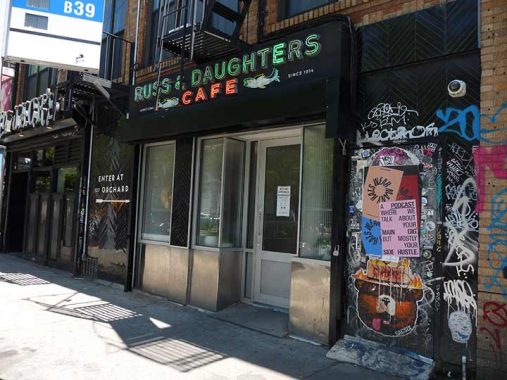
Speaking of classic neon here’s the entrance to Russ & Daughters Cafe on Allen Street, a smaller version of the appetizing store on Houston Street. The entrance at #127 Orchard features a minimalist sign that looks nothing like this.
Polish immigrant Joel Russ opened a pickled herring shop on Orchard Street in 1914. According to Historic Restaurants and Shops of New York, Russ had an irascible, argumentative personality, not an asset in the retail biz, so he put his three personable daughters to work behind the counter. The business evolved into a gourmet seafood delicacies emporium, still with a vintage 1940s neon sign on Houston Street.
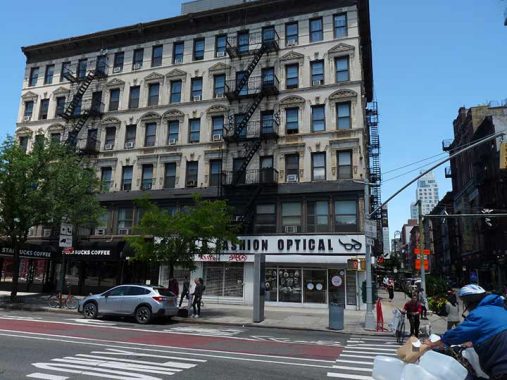
it’s Dueling Opticians at Delancey and Orchard, as Cohen’s Fashion Optical is in direct (literally) competition catercorner from Sol Moscot, immediately recognizable by its bright yellow signage (not pictured) at #94 Orchard. Moscot was founded on Rivington Street in 1915 after founder Hyman Moscot started selling eyeglasses from a pushcart in 1899.
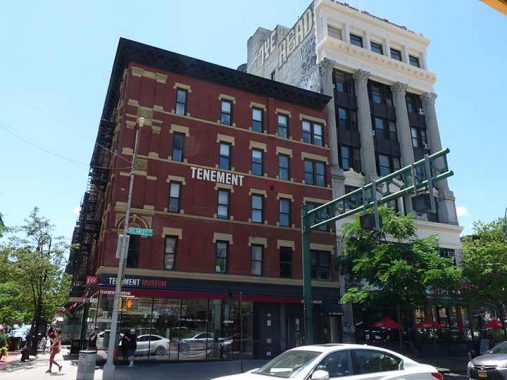
Lower East side residents of the late 1800s and early 1900s would be a little surprised, and more than a few would be somewhat bemused, to discover that their apartments had been converted into museum space. That’s exactly what happened at #97 Orchard Street just north of Broome, in apartments at one time rented by seamstress Nathalie Gumpertz, garment presser Abram Rogarshevsky, and the Confino and Baldizzi families, all representing different eras in the building’s long history. Originally constructed in 1867 without gas, hot water or flush toilets, it was like most of the other tenements in the area. Owners only installed these amenities after housing laws were passed around the turn of the 20th Century. During the last few years, tours have met and souvenirs have been purchased in the corner space at Delancey and Orchard. In the tenement itself, no photos please!
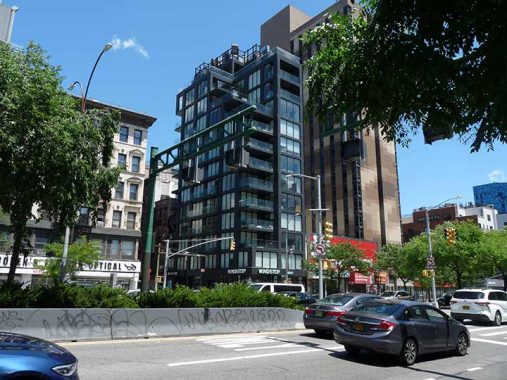
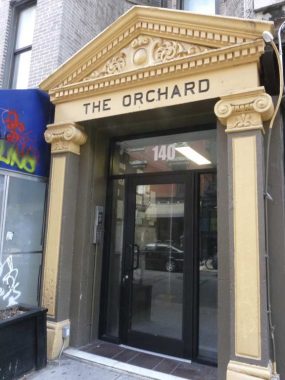
Despite the presence of a much older tenement building called The Orchard at #140 Orchard Street, the developers of #118 Orchard at Delancey named the 2019 condo building The Orchard anyway: so now there are two buildings called The Orchard on Orchard.
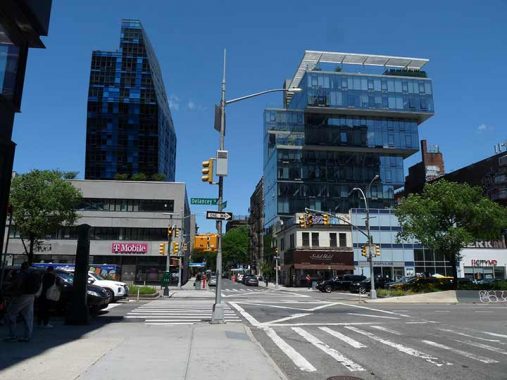
Blue glass towers #105 (left, itself called Blue) and #100 Norfolk Street face off north of Delancey. The latest trend in architecture is to stack boxes unevenly.
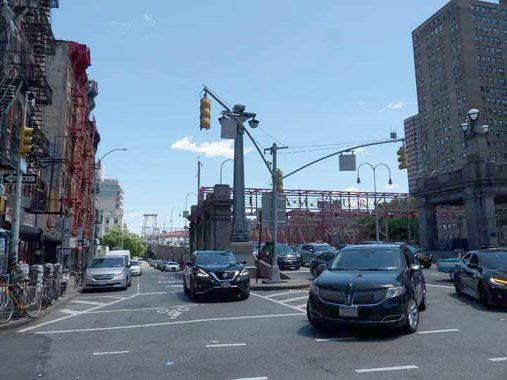
The west entrance to the Williamsburg Bridge, at Delancey and Clinton Street. It must be said, I’m not an enthusiastic Williamsburg walker, as the entrance ramp goes on forever until you get to the actual bridge, a fantastical erector set built in the 19-aughts. The ramp makes a spectacular appearance in the 1948 movie “Naked City.”
I did not call things to a halt here, but headed north on Clinton. If you can’t get enough Lower East Side, FNY did a multipart survey of its north-south streets in 2018. A golden era!
As always, “comment…as you see fit.” I earn a small payment when you click on any ad on the site.
7/31/22


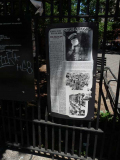
19 comments
As others may have observed, Kenmare isn’t a county; rather, it’s a location in County Kerry, in the southwest part of Ireland. Rather small, with a current population of 2,400, more or less.
As for 210 Lafayette, the April 26, 2002 New York Times states it was a parking lot before construction started; which doesn’t eliminate a gas station, but that seems to have been its last use.
The 1940s NYC Municipal Tax Photo shows 210 Lafayette as a lot with buildings on either side and in the rear. The 1980s Tax Photo under “204-10” Lafayette shows a parking lot.
Kevin–You might be remembering the gas station slightly farther north at 254 Lafayette. I think it survived into the 1990’s.
I like pizza, and I like clams, but I’ve tried clam ‘za elsewhere and the combo just doesn’t work.
And it’s a serious food crime in Italy to mix cheese and seafood!
Yes, the Williamsburg Bridge is a very important cast member in the 1948 classic film noir Naked City. The Manhattan side was completely rebuilt in the 1990s, so the movie gives an excellent view of the old bridge landing that is no longer there, including a rather impressive granite entryway. The movie’s last five minutes are right on the bridge, as the bad guy tries to elude the police. Excellent acting and photography work.
In reference to Police Lt. Petrosino, there is an excellent biopic about him called Pay or Die starring Ernest Borgnine. It is much more historically accurate than most biopics and presents a most wonderful recreation of New York in the early part of the 20th Century. I have a nice 16mm print of this very entertaining film.
Here’s more:
https://www.imdb.com/title/tt0054164/
BTW: It looks like the Lincoln in the last photo is making a hazardous & illegal right turn.
At least in this one, for being another tough guy role, he was the hero, not the heavy he usually played!
I wonder if the hallways smell like urine at the Tenement Museum just like
the real thing would have.This would certainly add to the authenticity of the
place.
The reason why this area had a good number of gas stations for being in Manhattan was because it used to be known as Gasoline Alley, but these days it’s hardly the case, though the one and Broadway and Lafayette Street is one of the few left at least to my knowledge.
As of 2016 there were only 12 remaining gas stations south of 96th Street. It might be even lower today.
The Corner Deli was the police command post for the operation against the subway CHUDs in the movie CHUD (Cannibalistic Humanoid Underground Dweller).
Tenement hallway odors? Cabbage being cooked!
I remember that
The Williamsburg Bridge was remodeled (as a previous commenter has stated) when it was discovered that years of neglected maintenance and moving metal subway cars had put the structure in danger of collapse in the next decade or two. The bridge had been designed before the subways were changed to all metal cars after the horrific tunnel accident where the original wooden chassis train cars completely disintegrated killing nearly everyone in the cars. The increased train weight over the years had caused metal stress to the bridge. While demolishing the bridge and replacing it was considered, some very smart engineering work came to the realization that the bridge would last for a very long time if the weight of the traffic and trains going up the inclines on both side were removed. So both sides connecting the two bridge towers to land have been replaced. Unfortunately that included removing the wide promenades on both sides.
Some fifteen years ago, or so, LaEsquina was a restaurant that was downstairs and in the sidewalk vaults of the street level diner. It was operated like a speakeasy in that you gave your name to a fellow at the door, who checked that you had a reservation. If you checked out, he would lead you to a door that was marked “Employees Only” and down a staircase that almost passed through the kitchen, into a darkly lit, windowless space. It was mostly original raw brick and sparingly decorated. When subway trains ran by, on the other side of the brick wall, the water in your drinking glasses would ripple from the vibrations. It was fun, but a bit expensive. I don’t know if the current restaurant space is still offering the “speakeasy” experience.
210 Lafayette never had a gas station. I recall the parking lot and Balazs’ project going up on it.